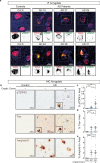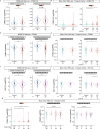Cryptic splicing of stathmin-2 and UNC13A mRNAs is a pathological hallmark of TDP-43-associated Alzheimer's disease
- PMID: 38175301
- PMCID: PMC10766724
- DOI: 10.1007/s00401-023-02655-0
Cryptic splicing of stathmin-2 and UNC13A mRNAs is a pathological hallmark of TDP-43-associated Alzheimer's disease
Abstract
Nuclear clearance and cytoplasmic accumulations of the RNA-binding protein TDP-43 are pathological hallmarks in almost all patients with amyotrophic lateral sclerosis (ALS) and up to 50% of patients with frontotemporal dementia (FTD) and Alzheimer's disease. In Alzheimer's disease, TDP-43 pathology is predominantly observed in the limbic system and correlates with cognitive decline and reduced hippocampal volume. Disruption of nuclear TDP-43 function leads to abnormal RNA splicing and incorporation of erroneous cryptic exons in numerous transcripts including Stathmin-2 (STMN2, also known as SCG10) and UNC13A, recently reported in tissues from patients with ALS and FTD. Here, we identify both STMN2 and UNC13A cryptic exons in Alzheimer's disease patients, that correlate with TDP-43 pathology burden, but not with amyloid-β or tau deposits. We also demonstrate that processing of the STMN2 pre-mRNA is more sensitive to TDP-43 loss of function than UNC13A. In addition, full-length RNAs encoding STMN2 and UNC13A are suppressed in large RNA-seq datasets generated from Alzheimer's disease post-mortem brain tissue. Collectively, these results open exciting new avenues to use STMN2 and UNC13A as potential therapeutic targets in a broad range of neurodegenerative conditions with TDP-43 proteinopathy including Alzheimer's disease.
Keywords: Alzheimer’s disease; Cryptic exons; SCG-10; Stathmin-2; TARDBP; TDP-43; UNC13A.
© 2024. The Author(s).
Conflict of interest statement
The authors report no competing interests to declare.
Figures




References
-
- Afroz T, Chevalier E, Audrain M, Dumayne C, Ziehm T, Moser R, Egesipe AL, Mottier L, Ratnam M, Neumann M, et al. Immunotherapy targeting the C-terminal domain of TDP-43 decreases neuropathology and confers neuroprotection in mouse models of ALS/FTD. Neurobiol Dis. 2023;179:106050. doi: 10.1016/j.nbd.2023.106050. - DOI - PubMed
-
- Allen M, Wang X, Burgess JD, Watzlawik J, Serie DJ, Younkin CS, Nguyen T, Malphrus KG, Lincoln S, Carrasquillo MM, et al. Conserved brain myelination networks are altered in Alzheimer’s and other neurodegenerative diseases. Alzheimers Dement. 2018;14:352–366. doi: 10.1016/j.jalz.2017.09.012. - DOI - PMC - PubMed
-
- Alquezar C, Salado IG, de la Encarnacion A, Perez DI, Moreno F, Gil C, de Munain AL, Martinez A, Martin-Requero A. Targeting TDP-43 phosphorylation by casein kinase-1delta inhibitors: a novel strategy for the treatment of frontotemporal dementia. Mol Neurodegener. 2016;11:36. doi: 10.1186/s13024-016-0102-7. - DOI - PMC - PubMed
Publication types
MeSH terms
Substances
Grants and funding
- P50 AG025711/AG/NIA NIH HHS/United States
- P30 AG019610/AG/NIA NIH HHS/United States
- R01 NS080820/NS/NINDS NIH HHS/United States
- R01 AG061796/AG/NIA NIH HHS/United States
- T32 GM008666/GM/NIGMS NIH HHS/United States
- U24 NS072026/NS/NINDS NIH HHS/United States
- R01 NS112503/NS/NINDS NIH HHS/United States
- U01 AG006786/AG/NIA NIH HHS/United States
- C06 RR016574/RR/NCRR NIH HHS/United States
- T32 AG066592/AG/NIA NIH HHS/United States
- R01 AG018023/AG/NIA NIH HHS/United States
- R38 AG065762/AG/NIA NIH HHS/United States
- P01 AG003949/AG/NIA NIH HHS/United States
- R01 AG032990/AG/NIA NIH HHS/United States
- T32 AG066596/AG/NIA NIH HHS/United States
- U19 AG074879/AG/NIA NIH HHS/United States
- P30 AG062421/AG/NIA NIH HHS/United States
- U01 AG046139/AG/NIA NIH HHS/United States
- P30 AG062429/AG/NIA NIH HHS/United States
- P01 AG017216/AG/NIA NIH HHS/United States
- P30 AG072980/AG/NIA NIH HHS/United States
LinkOut - more resources
Full Text Sources
Medical
Molecular Biology Databases
Miscellaneous

